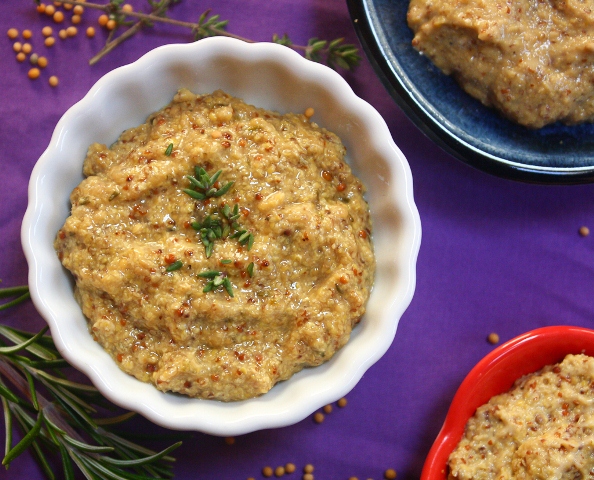
By Dana Zia
There is a little, tiny, round seed that has the mightiest of history and prowess. This wee seed has had powerful conversations with Alexander the Great, Pope John XII, Queen Victoria and none other than Jesus Christ and the Buddha. It has been used by the ancients to heal everything from scorpion stings to toothaches. On top of all that it has been a culinary delight since the early 4th century and the first domesticated crop ever. What is this humble seed? None other than the mighty mustard seed.
This seed’s birth place was the temperate regions of Europe so long ago no one remembers that it is indigenous there. There are three varieties of mustard, which is in the brassica family. There are the white or yellow seed, the black seed, and then the brown seed, which all come from different regions of Europe.
This teensy seed goes waaaaaay back! Our caveman ancestors probably sprinkled it on their raw meat before chowing down. Mustard’s first documented use was as a medicinal plant by the Greek scientist Pythagoras in the 6th century BC. He found it was a dandy poultice for scorpion stings and probably licked his finger after applying it one day and had a culinary epiphany because mustard really began to show up everywhere after that. I mean everywhere. Today it is often called the “Spice of Nations” because it is so universally used.
It certainly was in India in the 5th century BC, as Buddha knew enough about the mustard seed that he used it in a teaching to a distraught mother whom had asked Buddha to revive her dead son. He sent her out to gather mustard seeds from every family in the village whom had never lost a child, parent or friend. She came back empty handed, understanding that she was not alone in her grief.
This busy little seed also found its way to Galilee, 2000 years ago, where Jesus spoke of it in a parable. He said that the power of faith is like this least of seeds, mustard, that when sown it grows into the greatest of herbs, towering over all others. In fact this is exactly the reason that the Spanish Padres scattered mustard seed along the trails to missions in California, it towered so high and grew so well, it clearly marked the trail.
No matter where this mighty seed has traveled, the ones who truly discovered the amazing culinary uses of it were the French. There is no one that loves it more than them; they consume over 70% of the world’s crops in mustard. The French have been making and commercially selling Dijon mustard since 1634. They consider their mustard as important as wine, having different famous regions that produce their beloved crop. There is a good reason too; it is a flavor booster to many foods. I use it my salad dressings, soups, sauces and brownies. (Just kidding on the brownies) But seriously, try using it to boost whatever dish you are making. (It is excellent in elk stew!)
Add another cool culinary skill to your roster during the quarantine and make mustard all by yourself . There are many benefits to it, it tastes WAY better than store bought and isn’t full of preservatives and poor ingredients. It is very easy, all you need are the seeds, vinegar and a sturdy blender. You also need a bit of time as it take 2-3 days to soak the seeds in vinegar to get them to a tender stage to process them. Places where you can buy bulk spices should carry both the brown and the yellow mustard seeds. After you make your own, you will see what the French have known all along….. that mustard is the bomb!
Rosemary Thyme Mustard
This tangy mustard has impact! Very very good in chicken dishes and deviled eggs.
3 tablespoons of yellow mustard seeds
1 tablespoon of brown mustard seeds
3 teaspoons of fresh thyme (1.5 of dried)
3 teaspoons of minced fresh rosemary (1.5 of dried)
1/3 cup of apple cider vinegar
1/3 cup of water
1 teaspoon of honey
3/4 teaspoon of sea salt
Get out a non-reactive container, I like the pint sized canning jars, and add the mustard seeds, the herbs, water and vinegar. Put the lid on it and shake it up, then let set at room temp for 2-3 days, shaking it up whenever you get the urge. Get out your blender and blend the mix with the sugar and salt. Blend until the mixture is thick but still a coarse texture. Taste and adjust the seasonings, does it need more herbs? You have creative license here. Will last 3 weeks in the fridge, longer in the freezer.
Brandy Mustard
This mustard is soft and smooth like a good brandy. Very user friendly and blends well with everything.
6 Tablespoons of yellow mustard seeds
2 tablespoons of brown mustard seeds
3 tablespoons of brandy or Cognac (I used clear creek pear brandy)
2/3 cup of white wine vinegar
1/3 cup of water
1/4 cup of honey
1 teaspoon of salt
Get out a non-reactive container, I like the pint sized canning jars, and add the mustard seeds, the brandy, and the water and vinegar. Put the lid on it and shake it up, then let set at room temp for 2-3 days, shaking it up whenever you need to get out some nervous energy. Get out your metallically frothifier AKA blender and blend the mix with the sugar and salt. Blend until the mixture is as smooth as possible. Taste and adjust the seasonings. Will last 3-4 weeks in the fridge, longer in the freezer.
Your very own Dijon
This is it folks, your very own Gray Poupn. So very yummy to use as your everyday mustard and to cook with. Excellent with bratwursts and in potato salad.
½ cup of dry white wine
½ cup of white wine vinegar
¼ cup of brown mustard seeds
¼ cup of yellow mustard seeds
1 teaspoon of salt
Get out a non-reactive container,( I like the pint sized canning jars) and add the mustard seeds, the brandy, and the water and vinegar. Put the lid on it and shake it up, then let set at room temp for 2-3 days, shaking it up whenever you need to get shake something up. Using your blender, blend the mix up with the salt. Blend until the mixture is as smooth as possible. (keep in mind these whole grain mustards down blend till super smooth) Taste and adjust the seasonings. Will last 3-4 weeks in the fridge, longer in the freezer.


